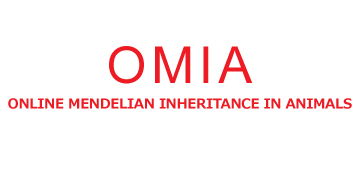HGTD This week, 28 May 2020: How OMIA is key to HGTD, and more fantastic phenes
HGTD, and IPFD, were thrilled to be able to send our very best wishes and acknowledgements to Prof Frank Nicholas, on the 25th Anniversary of the Online Mendelian Inheritance in Animals (OMIA) resource. (see Brenda's Blog) Collaboration with, and integration of OMIA's information is vital for a lot of what HGTD is able to do - and fundamental to animal genetics researchers the world over. OMIA is a catalogue/compendium of inherited disorders, other (single-locus) traits, and genes in 251 animal species. OMIA is a great example of collaboration in action - authored by Professor Frank Nicholas of the University of Sydney, Australia, but with expert input and help from many people over the years. For HGTD, it has provided a standardized, unique identifier number for the hundreds of phenes we list on the database, as well as additional information curated by Prof Nicholas and his contributors over the years. The OMIA number is something that can be recognized by genetic researchers across all countries, as a universal reference. It is a resource used by so many HGTD stakeholders, and accepted as something that just... feels like it has always existed. While it is hard to imagine creating HGTD and other resources without OMIA in place, it is easy to take fundamental resources like OMIA for granted that they will exist forever, always expanding, and up to date, without thinking about the challenges required to create them, and the perseverance to keep them going through the years. 
This concept was in my mind this week as I tackled adding in dozens of new breed-specific research publications and references, as well as updating OMIA references to phenes in the HGTD database.
As an integral part of HGTD's principle of transparency in reporting, providing up to date breed-specific and breed-relevant publications from peer-reviewed journals, as well as additional input from geneticists and researchers is a critical, but also a challenging and time-consuming aspect of maintaining the HGTD databases.
It requires regular review of OMIA, as new OMIA numbers are generated for new canine single-locus traits, collaboration with researchers who can provide important journal references, and the time and expertise to write and reference technically/clinically accurate phene descriptions, with language and wording that is accessible and clear to a wide audience.
This is part of why it was so important from the beginning of the Phenes database development, that we worked to include gene and mutation information for each phene, at a breed-specific as well as testing level. And, why we offer 2 descriptions for as many phenes as possible: a more technical/clinical description for our veterinary and research users, as well as a more real-life experience summary for dog owners and breeders.
It might be us who are putting this information in place, but it is only with the collaboration, and expert input from researchers and experts that we are able to have such a robust and responsive resource.
Thinking back to our friends at OMIA, I wonder (hope), that IPFD and the HGTD databases will in time be seen as a standard resource and reference for our diverse community, and be celebrating such an auspicious anniversary as OMIA, in the future.
With continued thanks, and appreciation to:


(puppy photo thanks to Mateja Lemic via Pexels)
 Donate
Donate
0 Comments
Recommended Comments
There are no comments to display.